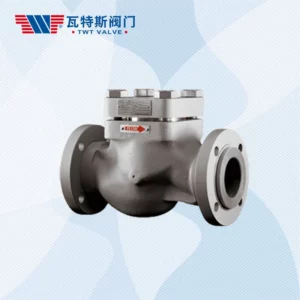The flange connection in a double door check valve is different from other valve types in several ways:
Flanged Ends: Double door check valves typically have flanged ends, which means they are designed to be bolted or screwed onto flanged pipe connections. This flange connection provides a secure and leak-tight attachment to the pipeline.
Two-Door Design: Double door check valves have two doors or plates that swing open to allow fluid to flow in one direction and then close to prevent reverse flow. These doors are attached to the valve body by hinges and are connected to the flanged ends, allowing them to pivot.
Reduced Pressure Drop: One of the advantages of the double door design is that it offers a lower pressure drop compared to some other check valve types. When the doors are open, they allow a more unobstructed flow of fluid.
Bolted Connection: The flange connection in double door check valves involves bolts and nuts to secure the valve to the flanged pipe ends. This bolted connection is more robust and provides a more reliable seal compared to some other types of connections.
Maintenance: Double door check valves with flange connections are relatively easier to install and maintain. If maintenance is required, the bolts can be loosened, and the valve can be removed without disassembling the entire piping system.
Application Flexibility: Flanged connections are common in a wide range of industries and applications. Double door check valves with flange connections can be used in various fluid systems, including water supply, sewage, oil and gas, and industrial processes.
It’s important to note that while flange connections are a notable feature of double door check valves, they are not exclusive to this valve type. Other check valve designs, such as swing check valves and lift check valves, can also feature flange connections depending on their specific design and application requirements.
How does a flange double door check valve differ from other types of check valves?
A flange double door check valve, also known as a dual plate check valve, differs from other types of check valves in several ways:
Two-Door Design: The most distinctive feature of a flange double door check valve is its dual-door or two-door design. It has two hinged doors or plates that swing open in the direction of flow and close to prevent backflow. This design provides a more streamlined and compact profile compared to some other check valve types, such as swing check valves or lift check valves.
Low Pressure Drop: The double door design of this check valve results in a lower pressure drop compared to some other check valve types. When the doors are open, they allow a more unobstructed flow of fluid, reducing the energy losses associated with pressure drop.
Compact Size: Flange double door check valves are typically more compact and lightweight than some other check valve types, making them suitable for applications with space constraints.
Fast Closure: The dual-door design allows for quick closure when reverse flow occurs. This rapid closure minimizes the risk of water hammer and associated damage to the piping system.
Minimal Water Hammer: The design of flange double door check valves is particularly effective in reducing water hammer, flange double door check valve which can be a concern in systems where flow is abruptly stopped or reversed.
Reduced Noise and Vibration: Because of their effective closure mechanism, flange double door check valves tend to produce less noise and vibration when compared to some other check valve types, enhancing system reliability and longevity.
Versatility in Flow Direction: Flange double door check valves are often designed to allow bidirectional flow, meaning they can effectively control flow in both directions, whereas some other check valves may be unidirectional.
Ease of Maintenance: These valves are relatively easy to install and maintain. The flange connections make installation straightforward, and if maintenance is required, the valve can be removed without disassembling the entire piping system.
Wide Range of Applications: Flange double door check valves are used in a variety of applications, including water supply, sewage, oil and gas, and industrial processes, due to their versatile design and ability to handle different fluids.
It’s important to note that while flange double door check valves have these unique characteristics, the choice of a check valve type depends on the specific requirements of the application, including factors like flow rate, fluid type, space constraints, and operating conditions. Different check valve designs may be more suitable for certain situations.
